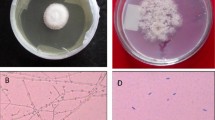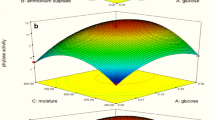Abstract
Solid-state bioprocessing of agricultural residues seems to be an emerging and effective method for the production of high quality animal feed. Seven strains of white-rot fungi were selected to degrade wheat and paddy straw (PS) under solid-state conditions. Degradation of different components, i.e., hemicellulose, cellulose and lignin was evaluated along with nutritional parameters including; in vitro digestibility, crude protein, amino acids, total phenolic contents (TPC) etc. Effect of nitrogen-rich supplements on degradation of lignocellulosics was evaluated using two best selected fungal strains (Phlebia brevispora and Phlebia floridensis). The best selected conditions were used to upscale the process up to 200 g batches of wheat and PS. Lignin was selectively degraded up to 30 % with a limited loss of 11–12 % in total organic matter. Finally, the degraded agro-residues demonstrated 50–62 % enhancement in their digestibility. Two–threefold enhancement in other nutritional quality (amino acids, TPCs and antioxidant activity) fortifies the process. Thus the method is quite helpful to design an effective solid-state fermentation system to improve the nutritive quality of agricultural residues by simultaneous production of lignocellulolytic enzyme production and antioxidants.



Similar content being viewed by others
References
Kejun S, Juntao Z, Ying C, Zongwen L, Lin R, Cong L (2011) Accelerating the degradation of green plant waste with chemical decomposition agents. J Environ Manag 92:2708–2713
Bisaria R, Madan M, Vasudevan P (1997) Utilisation of agro-residues as animal feed through bioconversion. Bioresour Technol 59:5–8
Arora DS, Sharma RK (2011) Effect of different supplements on bioprocessing of wheat straw by Phlebia brevispora: changes in its chemical composition, in vitro digestibility and nutritional properties. Bioresour Technol 102:8085–8091
Dong YC, Wang W, Hu ZC, Fu ML, Chen QH (2012) The synergistic effect on production of lignin-modifying enzymes through submerged co-cultivation of Phlebia radiata, Dichomitus squalens and Ceriporiopsis subvermispora using agricultural residues. Bioprocess Biosyst Eng 35:751–760
Arora DS, Gill PK (2000) Laccase production by some white rot fungi under different nutritional conditions. Bioresour Technol 73:283–285
Arora DS, Sharma RK (2009) Comparative ligninolytic potential of Phlebia species and their role in improvement of in vitro digestibility of wheat straw. J Animal Feed Sci 18:151–161
Sharma RK, Arora DS (2013) Fungal degradation of lignocellulosic residues: an aspect of improved nutritive quality. Crit Rev Microbiol. doi:10.3109/1040841X.2013.791247
Arora DS, Sharma RK (2009) Enhancement in in vitro digestibility of wheat straw obtained from different geographical regions during solid state fermentation by white rot fungi. Bioresources 4:909–920
Sharma RK, Arora DS (2010) Changes in biochemical constituents of paddy straw during degradation by white rot fungi and its impact on in vitro digestibility. J Appl Microbiol 109:679–686
Sharma RK, Arora DS (2011) Biodegradation of paddy straw obtained from different geographic locations by means of Phlebia spp. for animal feed. Biodegradation 22:143–152
Sharma RK, Arora DS (2010) Production of lignocellulolytic enzymes and enhancement of in vitro digestibility during solid state fermentation of wheat straw by Phlebia floridensis. Bioresour Technol 101:9248–9253
Datta R (1981) Acidogenic fermentation of lignocelluloses—acid yield and conversion of components. Biotechnol Bioeng 23:2167–2170
Dill I, Kraepelin G (1986) Palo Podrido: model for extensive delignification of wood by Ganoderma applanatum. Appl Environ Microbiol 52:1305–1312
Akhter S, Owen E, Theodorou MK, Butler EA, Minson DJ (1999) Bovine faeces as a source of micro-organisms for the in vitro digestibility assay of forages. Grass Forage Sci 54:219–226
Sharma RK, Chandra P, Arora DS (2010) Antioxidant properties and nutritional value of bioprocessed wheat straw by Phanerochaete chrysosporium and Daedalea flavida. J Gen Appl Microbiol 56:519–523
Chen GC, Johnson BR (1983) Improved colorimetric determination of cell wall chitin in wood decay fungi. Appl Environ Microbiol 46:13–16
Okano K, Iida Y, Samurai M, Prasetya B, Usagawa T, Watanabe T (2006) Comparison of in vitro digestibility and chemical composition among sugarcane bagasses treated by four white rot fungi. Animal Sci J 77:308–313
Jung HG, Valdez FRJ, Abad AR, Blanchette RA, Hatfield RD (1992) Effect of white rot basidiomycetes on chemical composition and in vitro digestibility of oat straw and alfalfa stems. J Animal Sci 70:1928–1935
Cohen R, Persky L, Hadar Y (2002) Biotechnological applications and potential of wood degrading mushrooms of the genus Pleurotus. Appl Microbiol Biotechnol 58:582–594
Chen J, Fales SL, Varga GA, Royse DJ (1995) Biodegradation of cell wall components of maize stover colonized by white-rot fungi and resulting impact on in vitro digestibility. J Sci Food Agric 68:91–98
Chen J, Fales SL, Varga GA, Royse DJ (1996) Biodegradability of free monomeric and cell-wall-bound phenolic acids in maize stover by two strains of white-rot fungi. J Sci Food Agric 71:145–150
Martinz ÁT, Speranza M, Dueñas FJR, Ferreira P, Camarero S, Guillén F, Martínez MJ, Gutiérrez A, Río JC (2005) Biodegradation of lignocellulosics: microbial, chemical, and enzymatic aspects of the fungal attack of lignin. Int Microbiol 8:195–204
Lena GD, Patroni E, Quaglia GB (1997) Improving the nutritional value of wheat bran by a white-rot fungus. Int J Food Sci Technol 32:513–519
Capelari M, Zadrazil F (1997) Lignin degradation and in vitro digestibility of wheat straw treated with Brazilian tropical species of white rot fungi. Folia Microbiol 42:481–487
Barahona R, Lascano CE, Narvaez N, Owen E, Morris P, Theodorou MK (2003) In vitro degradability of mature and immature leaves of tropical forage legumes differing in condensed tannin and non-starch polysaccharide content and composition. J Sci Food Agric 83:1256–1266
Sharma RK, Arora DS (2011) Solid state degradation of paddy straw by Phlebia floridensis in the presence of different supplements for improving its nutritive status. Int Biodeterior Biodegrad 65:990–996
Fazaeli H (2007) Nutritive value index of treated wheat straw with Pleurotus fungi. Biotechnol Animal Husb 23:169–180
Lateef A, Oloke JK, Kana GEB, Oyeniyi SO, Onifade OR, Oyeleye AO, Oladosu OC, Oyelami AO (2008) Improving the quality of agro-wastes by solid state fermentation: enhanced antioxidant activities and nutritional qualities. World J Microbiol Biotechnol 24:2369–2374
Arora DS, Sharma RK, Chandra P (2011) Biodelignification of wheat straw and its effect on in vitro digestibility and antioxidant properties. Int Biodeterior Biodegrad 65:352–358
Martins S, Mussatto SI, Martínez-Avila G, Montañez-Saenz J, Aguilar CN, Teixeira JA (2011) Bioactive phenolic compounds: production and extraction by solid-state fermentation: a review. Biotechnol Adv 29:365–373
Roche N, Venague A, Desgranges C, Durand A (1993) Use of chitin measurement to estimate fungal biomass in solid state fermentation. Biotechnol Adv 11:677–683
Kamra DN, Zadrazil F (1988) Microbiological improvement of lignocellulosics in animal feed production: a review. In: Zadrazil F, Reiniger P (eds) Treatment of lignocellulosics with white-rot fungi. Elsevier, Essex, pp 56–63
Acknowledgments
Rakesh Kumar Sharma is thankful to CSIR, India for the award of Senior Research Fellowship, File No. 09/254 (0226)/2110-EMR-I.
Author information
Authors and Affiliations
Corresponding author
Rights and permissions
About this article
Cite this article
Sharma, R.K., Arora, D.S. Bioprocessing of wheat and paddy straw for their nutritional up-gradation. Bioprocess Biosyst Eng 37, 1437–1445 (2014). https://doi.org/10.1007/s00449-013-1116-y
Received:
Accepted:
Published:
Issue Date:
DOI: https://doi.org/10.1007/s00449-013-1116-y




